|
|
|
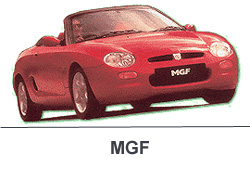 MGF History
MGF History
| This page contains: | MGF Model Evolution |
| The A to F of the MGF | |
| Why is the MG TF called a "TF"? |
The first all new MG for 32 years, the MGF was launched to critical acclaim at the 1995 Geneva Motorshow. Initial attention naturally focused upon the mouth-watering technical specifications of this land mark car for MG: the Hydragas suspension, exotic electric assisted power steering, mid-engine configuration and the award winning K-series engine that had been extended to 1.8 litres for this application (which on the VVC version had also acquired an ingenious variable valve timing mechanism). The styling of the car was judged a successful blend of old and new- with design cues harking back to the last of the MGBs, but with a stance that was uncompromisingly modern and forward looking.
As we look back now, we see what a superb piece of design the MGF represents: the essential design eliminates have endured with new minor interior changes for six years- before the vehicle's first comprehensive face lift in 2002. However, whilst the car has been left essentially cosmetically unchanged over this first six-year period, there have been a number of special editions, new models and detail alterations- and these are summarised below:
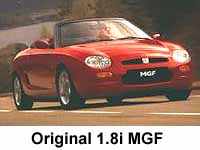 |
The Original MGF: 1.8i and VVC (1995-1999). Launched in 1995 as two models- the 1.8i and VVC, which possessed power outputs of 118 bhp and 143 bhp respectively. Standard equipment levels were good for the class of car: remote central & dead locking; passive arming immobiliser and remote activated perimetric and volumetric alarm (earning, in 1997, Thatcham Category 2 security status); electric windows and heated door mirrors. The VVC added further to this standard spec to include electrically assisted power steering (EPAS- which was to become standard on the 1.8i in 1998), ABS and half leather interior trim. |
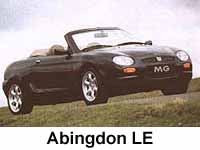 Legend has it this car is based upon the tweaks developed by Gerry McGovern for his own Tahiti blue car... |
The Abingdon LE (spring, 1998) was the first MGF special, limited-run edition, based upon both the 1.8i and VVC. The car's more luxurious specification included full (beige) leather upholstery, beige soft top and unique paint colour, Abingdon Green. Other cosmetic extras include an interior and exterior chrome pack- chrome ashtray and lighter, chrome exterior door handles and stainless steel grilles. Also standard, and first seen on this car, were the 6 spoke 'Abingdon style' 16" wheels, fitted with Goodyear F1 (214/40 R16) tyres. The 16" wheels were soon to be found on the options list for all MGFs and have proven an extremely popular design! |
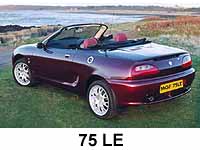 |
The 75 LE (March, 1999) was launched as a celebration model to commemorate the 75th anniversary of the MG car company (1924-1999). The specification of this model mirrored in many ways the earlier Abingdon LE with unique colours (Mulberry red and solid black) with leather and the fabric hood in a contrasting colour (black on red cars, red on black cars). Chrome interior and exterior highlights were as per Abingdon LE. Interestingly silver was a colour option offered in some markets (but not the UK). The 75 LE came with Multispoke design 16" wheels, and with either 1.8i or VVC engine options. |
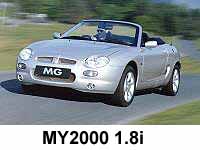
|
Mk2 / MY2000 MGF
(1999-2002). Autumn of 1999 saw the launch of
the improved 'Model Year (MY) 2000' MGF models, that are
also known amongst MG enthusiasts as the 'Mk2'. The cars
incorporated a number of detail improvements aimed at
eliminating some of the earlier car's weaknesses,
including re-specified EPAS, double skinned petrol tank
and detail changes to the cylinder head location and
gasket design. Cosmetic and specification changes were
few- what there were was aimed at improving the ambience
of the cabin- with the only external changes being the
painting of the windscreen surround in body colour where
previously it was painted black, and the change of colour
of the front indicator units from orange to smoked-clear
lenses. Thus the cars received new seats designed to
improve comfort and lateral support; the door trims now
included an alloy insert (or wood as an option), the
centre console was redesigned with an alloy theme
incorporated (such as the gear lever surround) and
improved switch gear. The heater controls were now silver
painted. Controversially, the instrument dials lost their
'MG' logos, and the cream faces changed for silver items
with a new italic type face. Compensation arrived in the
form of an improved six-speaker stereo, with a pair of
speakers beind the occupants' heads. VVC models retained their improved specification over 1.8i models. Where the 1.8i received new 8-spoke 'Minilite-style' wheels, the VVC received a new 16" 6-square spoke design. The interior is half leather, and the VVC receives ABS as standard. |
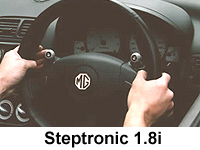 |
MGF
Steptronic (2000-). Introduced a little after
the MY2000 models, the Steptronic cars received a
technically advanced continuously variable automatic
transmission (CVT). This autobox includes a 'F1
paddle-shift' gear selection mode, that makes the gearbox
operate as a six-speed sequential gear box. The gears can
be selected either by the gear lever (push or pull) or
the selector buttons on the steering wheel (pictured
opposite). Unfortunately, this gearbox is only available
with the 1.8i engine, as the gearbox has an input speed
limit that is inadequate for the engine speeds that the
VVC engine is capable of. Performance figures are broadly lower than the standard manual 1.8i (although it is argued that this car is at least as fast in the real world), whilst trim specs are close to VVC levels. |
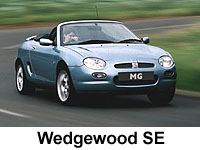 |
The Wedgwood SE (July, 2000) is the first limited edition based upon the MY2000 MGF. Following the successful formula struck by earlier limited editions, the car comes in a unique-for-MG colour, Wedgwood blue, and its improved standard specification includes leather seats, CD player, chrome interior and exterior accessories and 16" Multispoke wheels. This particular SE also possesses a rear deck spoiler- the first MGF to come so-equipped with it as standard. |
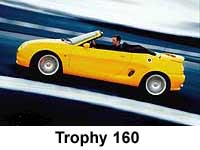 |
The Trophy
160 (May, 2001)- so named
because the re-tuning of the engine resulted in its VVC
engine producing 160 PS (158 bhp). Possibly the most
exciting and most comprehensively re-worked MGF special
edition so far. The mouth watering spec includes lowered
and stiffer suspension, AP racing 'MG' branded red
coloured 4 pot brake callipers acting on significantly
larger front brake discs, a new aerodynamic package
consisting of front splitter and rear deck spoiler and
that aforementioned engine. Other features include bold new colours- Trophy Yellow and Trophy Blue, a new style of 16" wheels and re-styled front head lamps. The interior has body coloured centre console and door trim inserts, plus coloured high-lights on the seats. Sure to be a classic. |
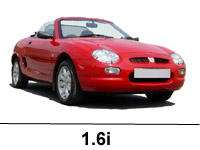 |
The MGF 1.6i (May, 2001) was launched somewhat quietly at the same time as its bigger, louder brother, the Trophy 160. Designed to compete at the other, cheaper end of the roadster market, the 1.6i competes head on with the similarly sized Mazda MX-5 (Eunos). Compared to the 1.8i, the car is de-spec'ed: no central locking, no volumetric alarm, no radio, no power adjustable mirrors, no fancy trim inlays for the doors. The car is meant to be cheap fun. Despite the capacity deficit, the 1.6 K-series is a ballsy rev- happy engine. Such is its effervescent character, one doesn't notice the performance deficit! In other words it succeeds in its aim- it's fun! |
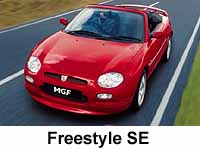 |
The MGF Freestyle (Autumn, 2001) was the last swan-song of the 'original' MGF before its radically face lifted replacement arrived in February 2002. Equipped with the cosmetic up grades already found on the MGF Trophy 160, the Freestyle thus came fitted with a Trophy-style front bib splitter and rear deck spoiler. The car also rides on 16" wheels, although this time using the familiar 'Multispoke' wheels featured on previous special edition MGFs. The Freestyle does without tuning upgrades found on the Trophy 160 or that car's superlative breaks, and as such is essentially based upon the standard model 1.8i and VVC. |
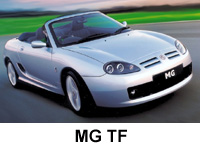 |
And now, the MG TF! (February, 2002) This car represents a dramatic stylistic departure for the MGF and includes a huge number of engineering changes. These include a new suspension system (the car is now sprung by coil-over damper units with a brand new multi-link rear) extensive body strengthening, and a new faster 2.8 turn lock to lock steering rack to name but three. The interior style is practically identical to the earlier MY2000 model, but now offers more colour choice and material options. In many ways, the new TF deserves a new name, although the 'T' prefix has caused some raised eyebrows in MG enthusiast circles. |
| Why is an MGF called an MGF? There are two rival explanations
for the genealogy of the name. The first is that the same
is simply a marketing ploy, exploiting the positive
associations between the letter 'F' and words like 'Fun'.
But the name appears to have more logic to it than
plucking a random letter and placing it after the
hallowed Morris Garages initials. The second explanation therefore, is that the F's name roots the modern MG into the marque's rich naming tradition. The 'current' naming system commenced with the launch of the first all new MG after the second world war- the MGA of 1955. The natural naming progression continued with that car's successor- the incredibly successful MGB, launched in 1963. A six cylinder variant of that car was launched in 1967. However, the MGC's life was short, being significantly outlived by the 4 cylinder MGB, which eventually ceased production (with the demise of the MG Abingdon plant at the hands of Sir Michael Edwards) in 1980. Behind the scenes however, long before the demise of the MGB, plans were afoot to replace the MGB/C. In the late sixties, the ADO21 project had been spawned. Based upon MGB underpinnings, but using an E-series engine pinched from the Austin Maxi mounted mid-ships, this car was to have been the first mid-engined MG- and probably the first affordable mid-engined sports car. Other elements of the design were dictated by the perceived risk of changes in US safety legislation- which was widely predicted to outlaw soft top convertible cars. Thus a targa design was alighted upon (similar in principle to the Fiat X1/9), with a flying buttress design that masked the height of the relatively tall engine. For better or for worse, that design did not get beyond the drawing board, as it lost out, in internal competition, to a design by Harris Mann for what was to become the Triumph TR7. However, whilst never seeing the light of day, this is the car what is popularly assumed to have acquired the MGD label. Interestingly, the mid-engine MG concept that was born with the MGD paper concept, was revived some 20 years later in the 1985 MG super car concept, the MG-EXE. Whilst never considered as a true production concept (the politics and image of the MG brand at the time ensured that the EXE stayed a motorshow fancy), the MG-EXE nonetheless was to have a profound influence upon the design direction of subsequent MG sports car concepts. An example of this influence can be seen in the rear lamp cluster design seen on the MGF- which is very reminiscent of those found on the MG-EXE. And so, having used the letters A through to E with either production cars or concepts for potential MGs, we arrive at the letter 'F'. And so it was, in 1995, that we saw the launch of the MGF- a name that surprised the motoring press of the time; the motoring pundits had widely predicted and fully expected the MGD tag for the car. Obviously there are gaps and discrepancies in this naming system. How does one fit in the MGB GT V8? Or the MG revival car, the MG RV8? And if one riffles through the 'secret' design proposals for potential MGs, one finds that the MGF tag had already been used- on the MG F-16 (the car that formed the basis for the later PR3 front/ front drive, mid/ rear drive and front/ rear drive development hacks used to evolve and hone the engineering concepts and parameters used in the car that we now know as the MGF). Which means of course, the most likely and plausible explanation for the MGF's name is, perhaps disappointingly, a marketing ploy- but one that at least has a certain logic and one that is based on the heritage of the world famous MG marque. Quite how the naming lineage will continue has only just become clear; it was always unlikely that the MG-G name would be used- primarily because in the UK 'Gee-gee' is a popular slang word for a race horse! So now we bid 'hello' to the new MG TF! |
`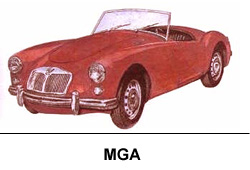 |
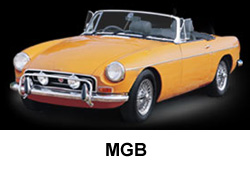 |
|
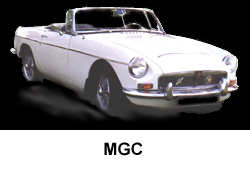 |
|
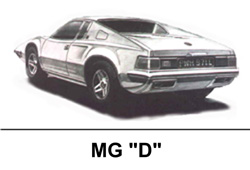 |
|
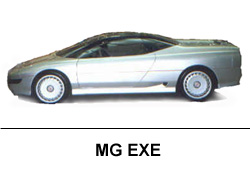 |
|
 |
Why is the MG TF called the "TF"?
This question is the subject of some debate in MG circles, where the name of a new MG carries more than average interest. As shown in the picture montage below, the TF name has already been used in a family of vehicles- the T-series Midget. This family lineage started before the war with the initial 'TA'. Without development funds being immediately available in the post war period, the design was further evolved with the TD and finally the TF in the early Fifties. Indeed, as stated in the MGF(TF) release literature, this was the last time that MG concurrently launched a sports car (the T-series) and a sports saloon (the Z-series).

The problem for MG enthusiasts is that the new TF bares no relationship with the earlier TF. In fact this is the first time an MG nameplate has been re-used. This may seem silly to some, but many are uncomfortable with this precedent. For me, it causes some confusion in writing this article, ensuring that you, the reader, knows which TF I am talking about! Personally, I feel that it is a little sad that the marketing team couldn't have come up with a better name than "TF". There are plenty of alternatives one could have used, and it seems more logical to continue with the "ABC..F" lineage discussed above. I guess this could be one of those arguements that could be set to run and run... but ultimately, the driving of the car counts more than the minor issue of names! Let the fun continue!
